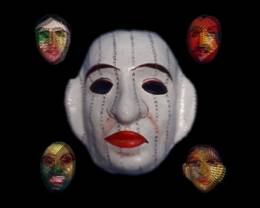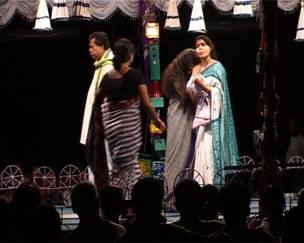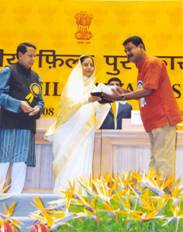Odiya Jatra: from Folk Entertainment to an Entertainment Industry
by Kapilas Bhuyan
 JATRA (a linguistic perversion of the Sanskrit ‘Yatra’) is one of the oldest forms of theater in Orissa. Some scholars trace it back to 2nd century B. C.; to the time of Kharavela, the emperor of Kalinga. In spite of such assertions, the origin of ‘Jatra’ is still surrounded by controversy. However, it would be pragmatic to trace back to its existing format to around 135 years ago, which roughly coincides with the emergence of modern Odiya drama.
JATRA (a linguistic perversion of the Sanskrit ‘Yatra’) is one of the oldest forms of theater in Orissa. Some scholars trace it back to 2nd century B. C.; to the time of Kharavela, the emperor of Kalinga. In spite of such assertions, the origin of ‘Jatra’ is still surrounded by controversy. However, it would be pragmatic to trace back to its existing format to around 135 years ago, which roughly coincides with the emergence of modern Odiya drama.
Thus, Jatra, a folk entertainment arose in the Orissa State of India nearly a score of centuries ago. But it was revived in 1875, in Orissa, when playwright Jagan Mohan Lal wrote and directed the first Odiya play, Babaji, which used a fusion of melodrama and music to tell culturally impacting stories.
It is a peripatetic folk theater performed in open-air, and follows broadly the prescriptions of Natya Shastra of Bharat Muni. In its earliest form, the themes for ‘Jatra’ were mostly mythological, but with the progress of time social themes began to enter the repertoire. During the last three decades, curiously, the distinction between ‘Jatra’ and cinema, not only in terms of thematic content but the spectacular aspect as well, has become increasingly blurred. ‘Jatra’ has become surrogate cinema, as it were, for its predominantly rural audiences.
The pre-eminence of Jatra can be attributed to the failing Oriya Film Industry due to blind imitation of Hindi films, lack of originality and poor return on huge investment. On the other hand, the exodus of film directors, actors and musicians into Jatra coupled with the rustic charm contributed to Jatra becoming money-spinning industry.
About three decades ago, the situation was not as rosy for Jatra as it is today. It was languishing as any other folk mediums in India and had gone almost to the verge of extinction. Earlier to this, in the nineteen-forties, the tradition of regular theater performance was unique to Orissa, which continued on the downslide until the mid-ninteen-sixties. But the next two decades were a phase of transition when Jatra continued to languish.
Most of the ‘A’ grade parties today were either renovated or established in the mid-ninteen-eighties. The Jatra troupes existing earlier, popularly known as ‘Operas’, were taken over and modernised with huge infusion of capital by the young inheritors / professional managers aiming at massive commercialization of Jatra, andthe new avtar came to be knownas ‘Gana Natyas’.
The attempt paid back, the shape and size of the stage changed – double stage was introduced, music pit from one side of the stage went up above to the same level making visible the players over there, the whole stage made into 18 to 21 sound zones (which was earlier only 3 to 5 sound zones during the single stage-era), flood lights were abandoned and large numbers of spot and dimmer lights were introduced, new audio equipments and modern musical instruments were incorporated to bring in lighting and effects, motor driven revolving and sliding center-stage with cyclorama on the back-stage and modern props came into being as part of gimmick, and thus resulting into a sea change in the Jatra scenario bringing people in flocks to buy tickets without hesitation.
 Like in Bollywood, in Odiya Jatra or in ‘Jollywood’ various combinations, viz. author-director, director-actor, director-music-director-lyricist-choreographer conjure up formulae that hit the jackpot. But there has to be enough strength in the theme of the play to attain success. More often than not it has always been a formula, but the formula changes.
Like in Bollywood, in Odiya Jatra or in ‘Jollywood’ various combinations, viz. author-director, director-actor, director-music-director-lyricist-choreographer conjure up formulae that hit the jackpot. But there has to be enough strength in the theme of the play to attain success. More often than not it has always been a formula, but the formula changes.
The days of the mythological & historical plays and traditional gallantry & sword fighting in Jatra are no more in vogue. Villain centric themes straight away lifted from celluloid potboilers were big hits just before a decade ago; however, the trend has changed to give room to socially relevant themes now.
Today, there are more than 120 big and small Jatra parties operating in the state and about1000 exhibitor-committees facilitate the staging of plays in different parts of Orissa. In every season there are 260 working days during which each of the Jatra parties perform up to 300 shows. The total turn over is approximately to the tune of 1500 million Indian Rupees, but as the real turn over is kept under wraps, no record is available for public.
As the monsoon weakens, by the third week of July Jatra parties start moving out in their yearly business trip – this happens after the rehearsal of at least 2 to 3 new plays at the base camp of each party between 15th June and 30th July every year. Apart from these 45 days, each party spends another 60 days in transit, and thus the remaining 260 days are the working days during which each party presents about 300 performances.
The exhibitor-committees all over the state play a vital role in facilitating the staging of Jatra in their respective localities – during the rehearsal days at the base camps the members of these committees make a reconnaissance trip to get the feel of the plays-in-preparation and scout the Jatra troupes to book for the current season. However, some of the mega parties by their track record of hit plays get booked beyond a single season. Whereas mega parties normally charge a threshold price for one night, others don’t enjoy this status and have to strike a deal on commission basis. The Jatra parties normally have their own transport, tent and kitchen provisions, and thus, the exhibitor-committees organize the stay of the workers and artists in their respective localities besides obtaining the permissions from the district authorities and maintaining the law and order situation during performances.
The bulk of the work-force of Jatra parties come from North Orissa that has several rivers like Mahanadi, Brahmani, Baitarani, Subarnarekha and their myriad tributaries and distributaries having their mouths open to the Bay of Bengal crisscrossing the entire topography of this region. The perpetual ravages of flood and natural calamities affect the crops so much so that the inhabitants of this part has been forced to migrate to far off places like Kolkota, Surat, New Delhi, Hyderabad, Mumbai, Bangalore and Goa to earn their livelihood. Jatra has brought within its ambit most of the youth by providing them with alternative means of livelihood thus preventing their imminent migration. Had Jatra not been there, involuntary migration would have been massive and unemployment would have assumed alarming proportion which could have contributed to the social instability.
 Today, Jatra provides the actors the scope to demonstrate their vast array of skills, which simply is not possible in other present-day mediums like in films, television and modern theater. Now exaggerated acting in Jatra performances has been toned down, male actors donning female garbs has become extinct to generate employment in Jatra for women as well.
Today, Jatra provides the actors the scope to demonstrate their vast array of skills, which simply is not possible in other present-day mediums like in films, television and modern theater. Now exaggerated acting in Jatra performances has been toned down, male actors donning female garbs has become extinct to generate employment in Jatra for women as well.
The thriving ‘Jatra’ today is not confined to its rural audiences alone. With urbanization and thanks to a large segment of rural people who have migrated to cities and towns in search of employment, ‘Jatra’ has been able to establish itself as a major form of entertainment in the urban areas too. Not surprisingly, the themes too have undergone a sea change. It has appropriated the themes from Hindi potboilers with the special effect to boot, yet while retaining certain rural values and a peculiarly rustic brand of humor that provides a sense of continuity.
While the general accusation against it has been that it represents a degeneration of the Odiya value system, it would be more realistic to regard it as a dynamic entertainment medium, which has shrewdly side stepped the competition from relatively more modern forms of entertainment as Theater, Cinema and even Satellite Television. Interestingly, the serials of ‘Jatra’ on television today stand on top on the popularity chart than any other entertainment programs.
The relationship of ‘Jatra’ to its immediate kin Cinema, in Orissa context, has always been dialectical. While the ‘Jatra’ contributed in a large measure to the film acting, they co-existed in their respective areas. While ‘Jatra’ held the sway in the rural areas, urban areas were the domains of cinema. The lack of exhibition facilities accounted for this clear divide. Their competitive claim for the same audience is only a recent phenomenon. With Odiya cinema failing to live up to the rising expectations of urban audience steeped in Hindi film culture, the investment in the industry plummeted sharply. While on the other hand ‘Jatra’, which had kept up its steady progress jumped in to fill the vacuum. Today, it is interesting to observe that, there is an exodus of Odiya film actors, musicians into ‘Jatra’. This has also resulted in large investments in ‘Jatra’ and consequently emergence of Mega Jatra Parties.
On another level, with the vast network of exhibitor-committees Jatra has spread to every nook and corner of the state where as the exhibition of films is confined to only about 120 accessible centers generating paltry revenue of only 200 million Indian Rupees. Thus, film industry in Orissa today, compared to the total turn over of Jatra parties, has turned out to be a poor cousin.
While on one hand the investment to create a ‘Jatra Party’ is at the least ten million Indian Rupees, and the top ranking parties even invest more to the tune of rupees 40 to 60 millions, on the other, the peripatetic performances of ‘Jatra’, around the state and outside, earn at least the livelihood of 200 to 300 troupe members of a single party, besides a handsome profit for the ‘Jatra Party’ owner. The employment opportunity in this industry is so good that women are no more hesitant to join as actors in the ‘Jatra Parties’ breaking the traditional male domain. Today, a single performance of ‘Jatra’ is being watched by somewhere between 5000 to 8000 people per show in one night, and the pricing of tickets are as high as Rs. 30/- to Rs. 100/- and more.
The success of Jatra has not been an overnight phenomenon, but it has been possible with total dedication and commitment of entire Jatra fraternity, meticulous planning and management, rigor in execution and continuous renovation. With an annual turn over of around 1500 million Indian Rupees, Jatra can claim a pride of place as a leading industry in an industrial backward state like Orissa, even though not formally recognized by the Govt. Jatra has provided succour to around 20,000 semi-literate rural youths with a fair sprinkling of women and also spawned another 10,000 part time jobs through its indirect potential who otherwise would have migrated elsewhere for alternative source of livelihood. Though it is an ordeal for the workers in the Jatra industry, it nevertheless, brings a sense of respectability and recognition to them.
 The gargantuan size of investment, massive employment and handsome revenues of Jatra has assumed the size of an industrial proportion. However, it has neither been accorded nor demanded the status so far of an Industry.
The gargantuan size of investment, massive employment and handsome revenues of Jatra has assumed the size of an industrial proportion. However, it has neither been accorded nor demanded the status so far of an Industry.
Ironically, Cinema, the poor cousin, has been accorded the status of an industry long back in nineteen eighties even though it generates much less revenue than Jatra. The promoters of Jatra on the other hand are put in a disadvantageous position vis-à-vis Cinema as they are deprived of soft loans and subsidies. However, through their own investment and entrepreneurial ability they have been instrumental in sustaining Jatra over the years. The professionals from Cinema now have moved to Jatra as they found it lucrative.
Although Jatra has become a profitable medium, it has failed to provide job security to its large work force. It so happened that when the actors demanded amelioration in their working condition, the owners of major Jatra parties formed a guild in 2004 to size them up. The actors tried to retaliate but could not muster courage until now to withstand their onslaught. It appears as if the Govt. is unaware and indifferent about it. If and only if, the owners guild show humanitarian gesture to provide pension benefits and health insurance to the workforce of Jatra, it will be a trend-setter for the unorganized work force not only at the state or national level, but in global context as well.
While various popular folk mediums like Tamasha in Maharastra, Nautanki in Utar Pradesh, Yakshagana in Karnatak and Bhavai in Gujarat are languishing due to lack of popular support and Jatra in Bengal has lost its earlier glory, and while various state run theater institutes in India have never been able to be self-sustaining, Odiya Jatra is no doubt exemplary for it has been a roaring success and still continuing to be so despite the Government apathy.

_______________________________________________________________
The author is a Senior Journalist and Filmmaker who has won several National and International awards. He has also received the President’s National Film Award for his film ‘Jatra Jeevan Jeevan Yatra’ as the Best Non-Fiction film in Art/Culture category. He may be contacted at kapilasbhuyan@gmail.com
 JATRA (a linguistic perversion of the Sanskrit ‘Yatra’) is one of the oldest forms of theater in Orissa. Some scholars trace it back to 2nd century B. C.; to the time of Kharavela, the emperor of Kalinga. In spite of such assertions, the origin of ‘Jatra’ is still surrounded by controversy. However, it would be pragmatic to trace back to its existing format to around 135 years ago, which roughly coincides with the emergence of modern Odiya drama.
JATRA (a linguistic perversion of the Sanskrit ‘Yatra’) is one of the oldest forms of theater in Orissa. Some scholars trace it back to 2nd century B. C.; to the time of Kharavela, the emperor of Kalinga. In spite of such assertions, the origin of ‘Jatra’ is still surrounded by controversy. However, it would be pragmatic to trace back to its existing format to around 135 years ago, which roughly coincides with the emergence of modern Odiya drama. Like in Bollywood, in Odiya Jatra or in ‘Jollywood’ various combinations, viz. author-director, director-actor, director-music-director-lyricist-choreographer conjure up formulae that hit the jackpot. But there has to be enough strength in the theme of the play to attain success. More often than not it has always been a formula, but the formula changes.
Like in Bollywood, in Odiya Jatra or in ‘Jollywood’ various combinations, viz. author-director, director-actor, director-music-director-lyricist-choreographer conjure up formulae that hit the jackpot. But there has to be enough strength in the theme of the play to attain success. More often than not it has always been a formula, but the formula changes.  Today, Jatra provides the actors the scope to demonstrate their vast array of skills, which simply is not possible in other present-day mediums like in films, television and modern theater. Now exaggerated acting in Jatra performances has been toned down, male actors donning female garbs has become extinct to generate employment in Jatra for women as well.
Today, Jatra provides the actors the scope to demonstrate their vast array of skills, which simply is not possible in other present-day mediums like in films, television and modern theater. Now exaggerated acting in Jatra performances has been toned down, male actors donning female garbs has become extinct to generate employment in Jatra for women as well. The gargantuan size of investment, massive employment and handsome revenues of Jatra has assumed the size of an industrial proportion. However, it has neither been accorded nor demanded the status so far of an Industry.
The gargantuan size of investment, massive employment and handsome revenues of Jatra has assumed the size of an industrial proportion. However, it has neither been accorded nor demanded the status so far of an Industry.